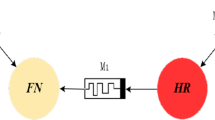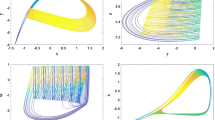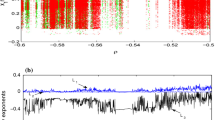Abstract
Biological neurons are capable of encoding a variety of stimuli, and the synaptic plasticity can be enhanced for activating appropriate firing modes in the neural activities. Artificial neural circuits are effective to reproduce the main biophysical properties of neurons when the nonlinear circuits composed of reliable electronic components with distinct physical properties are tamed to generate similar firing patterns as biological neurons. In this paper, a simple neural circuit is proposed to estimate the effect of magnetic field on the neural activities by incorporating two physical electronic components. A magnetic flux-controlled memristor and an ideal Josephson junction in parallel connection are used to percept the induction currents induced by the magnetic field. The circuit equations are obtained according to the Kirchhoff’s theorem and an equivalent neuron model is acquired by applying scale transformation on the physical variables and parameters in the neural circuit. Standard bifurcation analysis is calculated to predict possible mode transition and evolution of firing patterns. The Hamilton energy is also obtained to find its dependence on the mode selection in electronic activities. Furthermore, External magnetic field is applied to estimate the mode transition of neural activities because the phase error and the junction current across the Josephson junction can be adjusted to change the dynamics of the neural circuit. It is found that the biophysical functional neuron can present rapid and sensitive response to external magnetic field. Nonlinear resonance is obtained when stochastic phase error is induced by external time-varying magnetic field. The neural circuit can be suitable for further calculating the collective behaviors of neurons exposed to magnetic field.






















Similar content being viewed by others
References
Hodgkin, A.L., Huxley, A.F.: A quantitative description of membrane current and its application to conduction and excitation in nerve. J. Physiol. 117(4), 500–544 (1952)
Hodgkin, A.L., Huxley, A.F.: The components of membrane conductance in the giant axon of Loligo. J. Physiol. 116(4), 473–496 (1952)
Hodgkin, A.L., Huxley, A.F., Katz, B.: Measurement of current–voltage relations in the membrane of the giant axon of Loligo. J. Physiol. 116(4), 424–448 (1952)
Hodgkin, A.L., Huxley, A.F.: Propagation of electrical signals along giant nerve fibres. Proc. R. Soc. Lond. Ser. B-Biol. Sci. 140(899), 177–183 (1952)
Chay, T.R.: Abnormal discharges and chaos in a neuronal model system. Biol. Cybern. 50(4), 301–311 (1984)
Hindmarsh, J.L., Rose, R.M.: A model of the nerve impulse using two first-order differential equations. Nature 296(5853), 162–164 (1982)
Hindmarsh, J.L., Rose, R.M.: A model of neuronal bursting using three coupled first order differential equations. Proc. R. Soc. B Biol. Sci. 221(1222), 87–102 (1984)
Morris, C., Lecar, H.: Voltage oscillations in the barnacle giant muscle fiber. Biophys. J. 35, 193–213 (1981)
Gu, H., Pan, B., Chen, G., et al.: Biological experimental demonstration of bifurcations from bursting to spiking predicted by theoretical models. Nonlinear Dyn. 78, 391–407 (2014)
Wang, V.Q., Liu, S.: A general model of ion passive transmembrane transport based on ionic concentration. Front. Comput. Neurosci. 12, 110 (2019)
Lu, Q., Gu, H., Yang, Z., et al.: Dynamics of firing patterns, synchronization and resonances in neuronal electrical activities: experiments and analysis. Acta Mech. Sin. 24(6), 593–628 (2008)
Gu, H., Pan, B., Xu, J.: Experimental observation of spike, burst and chaos synchronization of calcium concentration oscillations. EPL 106(5), 50003 (2014)
Gu, H.G., Chen, S.G.: Potassium-induced bifurcations and chaos of firing patterns observed from biological experiment on a neural pacemaker. Sci. China Technol. Sci. 57(5), 864–871 (2014)
Chua, L.: Memristor-the missing circuit element. IEEE Trans. Circuit Theory 18(5), 507–519 (1971)
Kim, H., Sah, M.P., Yang, C., et al.: Memristor emulator for memristor circuit applications. IEEE Trans. Circuits Syst. I 59(10), 2422–2431 (2012)
Chanthbouala, A., Garcia, V., Cherifi, R.O., et al.: A ferroelectric memristor. Nat. Mater. 11(10), 860–864 (2012)
Yakopcic, C., Taha, T.M., Subramanyam, G., et al.: A memristor device model. IEEE Electron. Dev. Lett. 32(10), 1436–1438 (2011)
Ma, J., Tang, J.: A review for dynamics of collective behaviors of network of neurons. Sci. China Technol. Sci. 58(12), 2038–2045 (2015)
Wu, F., Wang, C., Xu, Y., et al.: Model of electrical activity in cardiac tissue under electromagnetic induction. Sci. Rep. 6(1), 28 (2016)
Ma, J., Wu, F., Hayat, T., et al.: Electromagnetic induction and radiation-induced abnormality of wave propagation in excitable media. Phys. A 486, 508–516 (2017)
Ge, M., Jia, Y., Xu, Y., et al.: Mode transition in electrical activities of neuron driven by high and low frequency stimulus in the presence of electromagnetic induction and radiation. Nonlinear Dyn. 91, 515–523 (2018)
Xu, Y., Jia, Y., Ge, M., et al.: Effects of ion channel blocks on electrical activity of stochastic Hodgkin–Huxley neural network under electromagnetic induction. Neurocomputing 283, 196–204 (2018)
Rostami, Z., Pham, V.T., Jafari, S., et al.: Taking control of initiated propagating wave in a neuronal network using magnetic radiation. Appl. Math. Comput. 338, 141–151 (2018)
Mvogo, A., Takembo, C.N., Fouda, H.P.E., et al.: Pattern formation in diffusive excitable systems under magnetic flow effects. Phys. Lett. A 381(28), 2264–2271 (2017)
Rostami, Z., Jafari, S., Perc, M., et al.: Elimination of spiral waves in excitable media by magnetic induction. Nonlinear Dyn. 94, 679–692 (2018)
Wouapi, M.K., Fotsin, B.H., Ngouonkadi, E.B.M., et al.: Complex bifurcation analysis and synchronization optimal control for Hindmarsh–Rose neuron model under magnetic flow effect. Cogn. Neurodyn. (2020). https://doi.org/10.1007/s11571-020-09606-5
Njitacke, Z.T., Doubla, I.S., Mabekou, S., et al.: Hidden electrical activity of two neurons connected with an asymmetric electric coupling subject to electromagnetic induction: coexistence of patterns and its analog implementation. Chaos Solitons Fract. 137, 109785 (2020)
Njitacke, Z.T., Doubla, I.S., Kengne, J., et al.: Coexistence of firing patterns and its control in two neurons coupled through an asymmetric electrical synapse. Chaos 30(2), 023101 (2020)
Njitacke, Z.T., Matze, C.L., Tsotsop M.F., et al.: Remerging feigenbaum trees, coexisting behaviors and bursting oscillations in a novel 3D generalized Hopfield neural network. Neural Process. Lett. 52, 267–289 (2020)
Parastesh, F., Rajagopal, K., Alsaadi, F.E., et al.: Birth and death of spiral waves in a network of Hindmarsh–Rose neurons with exponential magnetic flux and excitable media. Appl. Math. Comput. 354, 377–384 (2019)
Rajagopal K., Moroz I., Karthikeyan A., et al.: Wave propagation in a network of extended Morris-Lecar neurons with electromagnetic induction and its local kinetics. Nonlinear Dyn. 100, 3625–3644 (2020)
Rajagopal, K., Parastesh, F., Azarnoush, H., et al.: Spiral waves in externally excited neuronal network: solvable model with a monotonically differentiable magnetic flux. Chaos 29(4), 043109 (2019)
Ma, J., Yang, Z., Yang, L., et al.: A physical view of computational neurodynamics. J. Zhejiang Univ. Sci. A 20(9), 639–659 (2019)
Tang, J., Ma, J., Yi, M., et al.: Delay and diversity-induced synchronization transitions in a small-world neuronal network. Phys. Rev. E 83, 046207 (2011)
Tripathy, S.J., Padmanabhan, K., Gerkin, R.C., et al.: Intermediate intrinsic diversity enhances neural population coding. Proc. Natl. Acad. Sci. 110(20), 8248–8253 (2013)
Xu, Y., Wang, C., Lv, M., et al.: Local pacing, noise induced ordered wave in a 2D lattice of neurons. Neurocomputing 207, 398–407 (2016)
Perc, M.: Stochastic resonance on weakly paced scale-free networks. Phys. Rev. E 78, 036105 (2008)
Nishikawa, T., Motter, A.E., Lai, Y.C., et al.: Heterogeneity in oscillator networks: are smaller worlds easier to synchronize? Phys. Rev. Lett. 91, 014101 (2003)
Mejias, J.F., Longtin, A.: Optimal heterogeneity for coding in spiking neural networks. Phys. Rev. Lett. 108, 228102 (2012)
Belykh, I.V., Belykh, V.N., Hasler, M.: Blinking model and synchronization in small-world networks with a time-varying coupling. Phys. D 195(1–2), 188–206 (2004)
So, P., Cotton, B.C., Barreto, E.: Synchronization in interacting populations of heterogeneous oscillators with time-varying coupling. Chaos 18, 037114 (2008)
Buhmann, J., Schulten, K.: Influence of noise on the function of a “physiological” neural network. Biol. Cybern. 56(5–6), 313–327 (1987)
Tang, J., Zhang, J., Ma, J., et al.: Noise and delay sustained chimera state in small world neuronal network. Sci. China Technol. Sci. 62(7), 1134–1140 (2019)
Jin, W.Y., Wang, A., Ma, J., et al.: Effects of electromagnetic induction and noise on the regulation of sleep wake cycle. Sci. China Technol. Sci. 62, 2113–2119 (2019)
Neiman, A.B., Russell, D.F.: Synchronization of noise-induced bursts in noncoupled sensory neurons. Phys. Rev. Lett. 88, 138103 (2002)
Ermentrout, G.B., Galán, R.F., Urban, N.N.: Reliability, synchrony and noise. Trends Neurosci. 31(8), 428–434 (2008)
Wang, C., Ma, J.: A review and guidance for pattern selection in spatiotemporal system. Int. J. Mod. Phys. B 32, 1830003 (2018)
Kim, H., Sah, M.P., Yang, C., et al.: Neural synaptic weighting with a pulse-based memristor circuit. IEEE Trans. Circuits Syst. I 59, 148–158 (2011)
Adhikari, S.P., Kim, H., Budhathoki, R.K., et al.: A circuit-based learning architecture for multilayer neural networks with memristor bridge synapses. IEEE Trans. Circuits Syst. I 62, 215–223 (2014)
Hiltz, F.F.: Artificial neuron. Kybernetik 1(6), 231–236 (1963)
Harmon, L.D.: Artificial neuron. Science 129(3354), 962–963 (1959)
Wu, F., Ma, J., Zhang, G.: A new neuron model under electromagnetic field. Appl. Math. Comput. 347, 590–599 (2019)
Nguetcho, A.S.T., Binczak, S., Kazantsev, V.B., et al.: Experimental active spike responses of analog electrical neuron: beyond “integrate-and-fire” transmission. Nonlinear Dyn. 82, 1595–1604 (2015)
Wu, H., Bao, B., Liu, Z., et al.: Chaotic and periodic bursting phenomena in a memristive Wien-bridge oscillator. Nonlinear Dyn. 83, 893–903 (2016)
Hu, X., Liu, C., Liu, L., et al.: An electronic implementation for Morris–Lecar neuron model. Nonlinear Dyn. 84, 2317–2332 (2016)
Korkmaz, N., Öztürk, İ., Kılıç, R.: The investigation of chemical coupling in a HR neuron model with reconfigurable implementations. Nonlinear Dyn. 86, 1841–1854 (2016)
Heidarpur, M., Ahmadi, A., Kandalaft, N.: A digital implementation of 2D Hindmarsh–Rose neuron. Nonlinear Dyn. 89, 2259–2272 (2017)
Liu, Y., Xu, W.J., Ma, J., et al.: A new photosensitive neuron model and its dynamics. Front. Inf. Technol. Electron. Eng. 21(9), 1387–1396 (2020)
Zhang, X.F., Wang, C.N., Ma, J., et al.: Control and synchronization in nonlinear circuits by using a thermistor. Mod. Phys. Lett. B 34(25), 2050267 (2020)
Chen, L., Zhou, Y., Yang, F., et al.: Complex dynamical behavior in memristor-capacitor systems. Nonlinear Dyn. 98, 517–537 (2019)
Wang, N., Zhang, G., Bao, H.: Bursting oscillations and coexisting attractors in a simple memristor-capacitor-based chaotic circuit. Nonlinear Dyn. 97, 1477–1494 (2019)
Tan, Q., Zeng, Y., Li, Z.: A simple inductor-free memristive circuit with three line equilibria. Nonlinear Dyn. 94, 1585–1602 (2018)
Yuan, F., Deng, Y., Li, Y., et al.: The amplitude, frequency and parameter space boosting in a memristor–meminductor-based circuit. Nonlinear Dyn. 96, 389–405 (2019)
Zhang, J., Liao, X.: Effects of initial conditions on the synchronization of the coupled memristor neural circuits. Nonlinear Dyn. 95, 1269–1282 (2019)
Wu, F., Ma, J., Ren, G.: Synchronization stability between initial-dependent oscillators with periodical and chaotic oscillation. J. Zhejiang Univ. Sci. A 19(12), 889–903 (2018)
Gu, H., Pan, B., Li, Y.: The dependence of synchronization transition processes of coupled neurons with coexisting spiking and bursting on the control parameter, initial value, and attraction domain. Nonlinear Dyn. 82, 1191–1210 (2015)
Wu, F., Zhang, Y., Zhang, X.: Regulating firing rates in a neural circuit by activating memristive synapse with magnetic coupling. Nonlinear Dyn. 98, 971–984 (2019)
Chen, C., Chen, J., Bao, H., et al.: Coexisting multi-stable patterns in memristor synapse-coupled Hopfield neural network with two neurons. Nonlinear Dyn. 95, 3385–3399 (2019)
Takembo, C.N., Mvogo, A., Fouda, H.P.E., et al.: Effect of electromagnetic radiation on the dynamics of spatiotemporal patterns in memristor-based neuronal network. Nonlinear Dyn. 95, 1067–1078 (2019)
Xu, F., Zhang, J., Jin, M., et al.: Chimera states and synchronization behavior in multilayer memristive neural networks. Nonlinear Dyn. 94, 775–783 (2018)
Chang, W.H.: Measurement and calculation of Josephson junction device inductances. J. Appl. Phys. 52(3), 1417–1426 (1981)
Terzioglu, E., Beasley, M.R.: Complementary Josephson junction devices and circuits: a possible new approach to superconducting electronics. IEEE Trans. Appl. Supercond. 8(2), 48–53 (1998)
Crotty, P., Schult, D., Segall, K.: Josephson junction simulation of neurons. Phys. Rev. E 82, 011914 (2010)
Dana, S.K., Sengupta, D.C., Hu, C.K.: Spiking and bursting in Josephson junction. IEEE Trans. Circuits Syst. II 53(10), 1031–1034 (2006)
Pikovsky, A.S., Kurths, J.: Coherence resonance in a noise-driven excitable system. Phys. Rev. Lett. 78, 775–778 (1997)
Jia, Y.B., Gu, H.G.: Phase noise-induced double coherence resonances in a neuronal model. Int. J. Mod. Phys. B 29, 1550142 (2015)
Zhang, Y., Wang, C.N., Tang, J., et al.: Phase coupling synchronization of FHN neurons connected by a Josephson junction. Sci. China Technol. Sci. (2020). https://doi.org/10.1007/s11431-019-1547-5
Wu, F.Q., Ma, J., Zhang, G.: Energy estimation and coupling synchronization between biophysical neurons. Sci. China Technol. Sci. 63(4), 625–636 (2020)
Kobe, D.H.: Helmholtz’s theorem revisited. Am. J. Phys. 54, 552–554 (1986)
Sarasola, C., Torrealdea, F.J., D’Anjou, A., et al.: Energy balance in feedback synchronization of chaotic systems. Phys. Rev. E 69, 011606 (2004)
Huang, F., Bladon, J., Lagoy, R.C., et al.: A photosensitive surface capable of inducing electrophysiological changes in NG108-15 neurons. Acta Biomater. 12, 42–50 (2015)
Xu, Y., Guo, Y.Y., Ren, G.D., et al.: Dynamics and stochastic resonance in a thermosensitive neuron. Appl. Math. Comput. 385, 125427 (2020)
Xu, Y., Liu, M.H., Zhu, Z.G., et al.: Dynamics and coherence resonance in a thermosensitive neuron driven by photocurrent. Chin. Phys. B 29, 098704 (2020)
Acknowledgements
This project is partially supported by National Natural Science Foundation of China under the Grant Nos. 11672122 and 12072139.
Author information
Authors and Affiliations
Corresponding author
Ethics declarations
Conflict of interest
The authors declare that they have no conflict of interest.
Additional information
Publisher's Note
Springer Nature remains neutral with regard to jurisdictional claims in published maps and institutional affiliations.
Rights and permissions
About this article
Cite this article
Zhang, Y., Xu, Y., Yao, Z. et al. A feasible neuron for estimating the magnetic field effect. Nonlinear Dyn 102, 1849–1867 (2020). https://doi.org/10.1007/s11071-020-05991-y
Received:
Accepted:
Published:
Issue Date:
DOI: https://doi.org/10.1007/s11071-020-05991-y




